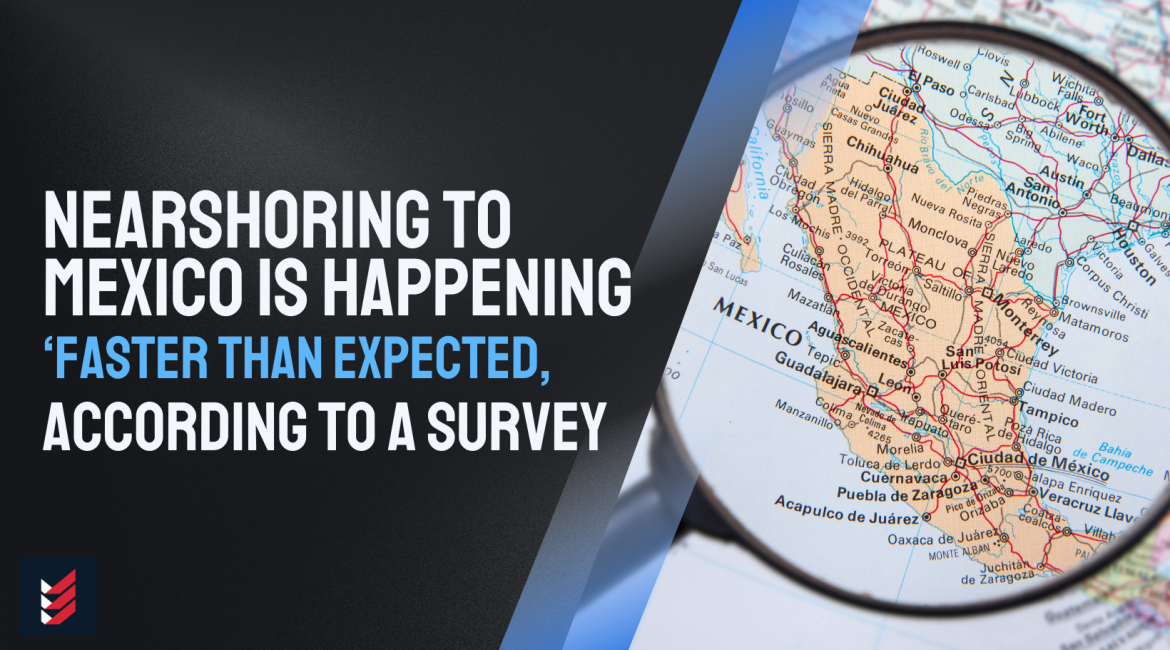While nearshoring to Mexico has been steadily increasing over the last decade, the pandemic and other recent global disruptions have accelerated the trend.
According to a recent survey conducted by Gartner-owned consultant Capterra, approximately 88% of US-based small and medium-sized businesses (SMBs) will restructure their supply chains to use suppliers in the US or Mexico by 2023.
Faster-Than-Expected Transition to Nearshoring
“The shift to nearshoring is happening faster than predicted in 2021,” according to the survey. “Most industry professionals predicted that this change would take five or more years. However, the data show that even the 2022 numbers were higher than predicted, and 2023 will continue to see a rapid shift to nearby suppliers.”
Capterra, an Arlington, Virginia-based software consultancy and review site, surveyed 300 supply chain SME professionals in the United States for the study titled “From Nearshoring to Mexico to Cooperative Procurement.”
According to the survey, while 88% of SMBs intend to switch at least some of their suppliers to those located in the United States or nearby, 45% intend to switch all of them.
Key Drivers for Shifting to North American Suppliers
Survey respondents cited shorter supply chains, the US-Mexico-Canada Agreement trade pact, lower labor costs in Mexico, and North American transportation infrastructure as reasons for shifting manufacturing sources.
According to Ben Johnston, chief operating officer at Kapitus, his company anticipates that nearshoring of manufacturing to Mexico, which has an established manufacturing base and low tariff trade agreements with the United States, will become more common in the coming years.
Kapitus and Its Role in Financing
New York City-based Kapitus is a small business and industrial equipment financing company based in the United States that provides funding for everything from construction companies to health care providers to small manufacturers.
“Mexico already has a significant manufacturing presence, including many precision technology manufacturers,” Johnston explained to FreightWaves.
While automotive vehicle and parts manufacturing, consumer electronics, and medical equipment have long been a part of the US-Mexico supply chain, Johnston predicts that production of electrical components related to green technology will increase.
Government Support for Infrastructure and Green Technologies
“The Infrastructure [Investment and Jobs] Act of 2021 and the Inflation Reduction Act of 2022 provide significant funding to stimulate investment in infrastructure and green technologies,” Johnston explained. “Many of these incentives require manufacturing of subsidized products to occur in the U.S., or with approved trading partners, of which Mexico is included. Furthermore, new regulations prohibiting the manufacture of certain items deemed critical to national defense in China will drive additional high-tech manufacturing to the United States, Mexico, and other U.S. allies.”
According to the survey, 65% of supply chain professionals worry about economic inflation in 2023, followed by concerns over a lack of inventory (43%) and economic recession (42%).
“SMBs are hit harder than larger companies because they have more resources to absorb higher procurement and logistics costs and to reduce operating costs, such as labor,” according to the survey.
Concerns about inflation, according to Johnston, have already begun to influence how SMBs source their supply chain this year.
“The trend toward manufacturing repatriation to the United States will continue in 2023, as long supply chains and geopolitical unrest drive businesses to seek more reliable alternatives,” Johnston predicted. “Continued cost reduction for U.S. manufacturers is critical as a strong dollar has hurt the competitiveness of U.S. manufacturing on the global stage and is slowing the overall repatriation trend. Inflation remains a concern for U.S. manufacturers, but we are currently seeing a slowing of both the consumer and producer price indexes, which we expect to continue throughout the year, making inflation less of a long-term concern for manufacturers.”
